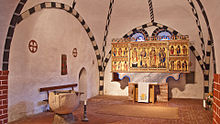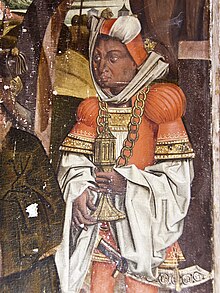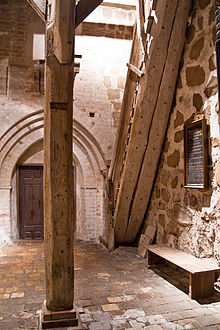Bernitt village church
The Evangelical Lutheran village church Bernitt is a field stone church in the municipality of Bernitt in the Rostock district not far from the town of Bützow in Mecklenburg-Western Pomerania. The parish belongs to the Rostock provost in the Mecklenburg parish of the Evangelical Lutheran Church in Northern Germany ( Northern Church ).
location
The Bützower Land, in which Bernitt is also located, is like the entire landscape of Mecklenburg the result of the Ice Age (the last Ice Age began about 29,000 years ago and lasted 13,000 years) and was formed by the weight and slow movement of the ice masses. Plains, rivers and river valleys, lakes and pools, ridges and hills therefore characterize the Bernitter area.
Architecture and history
The Bernitter church and the Bernitter pastor Herbord are named for the first time in the deed of approval of the Rühn monastery from 1233.
The Bernitter Church is a field stone building with windows, portals and vaults made of brick. It was built in three construction phases. It started with the choir , followed by the nave and finally the tower. The choir is older than the nave and dates from the middle of the 13th century, while the nave was added about 40 years later. The tower of the church dates from the 15th century. The exact dendrological data are:
- Choir: 1263d
- Ship: 1302d
- Tower: 1434d
Field stones were used to build the church, which were carefully hewn and walled up in layers, as well as partly only split or used untreated. The structure of the walls consists of brick field stones inside and outside, the space between them being filled with fragments, rubble and mortar and pasted. The wall thickness varies according to measurements between 133 and 217 cm. Bricks were only used for the window reveals and parts of the tower. The east gable is plastered with a late Romanesque round arch frieze that dates back to the 13th century. During its restoration, old incisions were discovered under the arch, which indicate a rose window that was originally intended to adorn the gable with a rose window.
The vaulted disc from the 15th century in the nave, which shows a relief bust of Peter, was only moved from the choir vault to the western nave vault in the 20th century. However, it is unclear whether the choir vault was its original location.
The neo-Gothic stalls and the gallery in the nave are more recent and date from the 19th century. Whereas the pulpit is from the 17th century. The crucifix above the passage from the nave to the choir dates from the 14th (Schlie) or 15th (Dehio) century.
The Bernitter Church is one of the few churches in Mecklenburg from the 13th century that the Reformation apparently left behind without a trace. The interior of the church, especially the choir, is well preserved. From the Middle Ages there are vault paintings in the nave and a large baptismal font and pre-Reformation wall niches in the choir .
Description and equipment
The Bernitter Church has been described several times. The first longer account can be found in the yearbooks of the Association for Mecklenburg History and Archeology. On the occasion of the discovery of the vault paintings, a further description was given in the Mecklenburg yearbooks. The Bernitter Church is also shown in the standard work "The Art and History Monuments of the Grand Duchy of Mecklenburg-Schwerin" by Schlie . Further individual and short descriptions can be found in various publications, u. a. in the art guide Dehio . A current description was published in 2011. An art-historical classification of the winged altar in the choir was carried out as part of Julia Trinkert's dissertation, which was published in 2015 as part of the series “Studies on international architecture and art history”.
Choir and altar
In the choir there are late Romanesque choir windows and medieval vault paintings. Pre-Reformation wall niches ( sacrament cupboard , safe, 3 sideboard niches ) and a Romanesque baptismal font complete the ensemble. A Gothic winged altar from around 1515–1520 forms the center of the choir. The carved winged altar was probably made in Parchim in Mecklenburg. On the wings of the altar (height: 154.5 cm, width 101.5 cm, depth: 10.5 cm) the Twelve Apostles are depicted, in the center of the altar you can see the shrine (height: 154.5 cm, width 203 cm, depth: 14 cm) four saints (assigned attributes in brackets):
- Left wing: Johannes (chalice), Thomas (fragmentary lance, scroll), Peter (key, book), Bartholomew (lost knife), Philip (T-cross with crossbar), Simon (saw)
- Right wing: Paulus (sword), Judas Thaddäus (stick), Jacobus Minor (fragmentary walker's pole, "wool bow"), Andreas (inclined cross), Matthew (book bag, fragmentary hatchet), Jacobus Major (pilgrim costume, shell on pilgrim hat, walking stick and - bag)
- Middle shrine: Saint Erasmus (winds), Mother Mary ( Crescent Madonna ), Saint Catherine of Alexandria (sword and wheel) and Saint George (lance, dragon)
The original predella of the winged altar is no longer there. On the back of the Bernitter Altar there are biblical depictions from the life of Mary and the childhood of Jesus, but these are badly damaged. The scenes of the Annunciation to Mary, the birth of Jesus, the adoration of the Magi and the circumcision are shown. The quality of the faded paintings, which are believed to be of local origin, is outstanding. South German and Dutch models are suspected. The particular care taken in the execution of the figures with regard to the faces and the robes should be emphasized. An art-historical classification of these panel paintings is still pending.
The preservation of the medieval, pre-Reformation wall niches is remarkable, since these were often removed after the Reformation. The old sacrament cabinet is in the north wall of the choir. The 15th century Man of Sorrows is depicted on the inside of the door. The safe is embedded in the east side of the choir and equipped with massive locking options. The 3 sideboards are in the south wall of the choir. They were used to temporarily store the sacrament implements during the service.
The Romanesque baptismal font was not originally in the choir, but in the tower. But it is much older than the tower and comes from the. 13th Century. It was moved to the choir room at the end of the 20th century.
Paintings
There are medieval paintings in the nave. The creation of the paintings is dated to the period around 1280-1350. The paintings were preserved until the 18th century, but were then whitewashed in 1794. They were not rediscovered until 1859 and were faithfully restored. The paintings in the nave of the church are among the oldest scenic representations in northern Germany. Scenes of the Passion of Christ and the Last Judgment are depicted on the main surfaces of the vaulted caps. The scenes are depicted: Flagellation, Carrying of the Cross, Crucifixion, Descent into Hell, Resurrection, Noli me tangere , Last Judgment. In the spandrels there are more secular depictions of sins and temptations as well as mythical animals. Examples are the depiction of the cooper and the devil, as well as fantastic dragon figures in the southeast corner. The depiction of a fraudulent wine tavern that the devil has in his claws is a living figure in the popular imagination of the time.
In addition to the vault and spandrel paintings, wall paintings were also found in 1859. In contrast to the vault and spandrel paintings, these were not restored, but painted over again after their discovery. Probably because her condition was too bad. However, Lisch provides a detailed description of these wall paintings.
The paintings visible in the choir today were hidden in 1859 and were only rediscovered in 1984. What is unusual about these medieval vault paintings is the fact that they are completely black and white.
organ
In 1896 an organ harmonium was bought from Burger (Bayreuth) and used for the first time at Whitsun. In the year of the 700th anniversary of the Bernitter Church, a new organ was installed in 1933, but from 1969 onwards it could no longer be used. In 1974 an organ with a manual, 5 stops and a pedal with its own stop was built by the organ building company Wolfgang Nussbücker (Plau).
Bell tower and bells
The tower has an eight-sided helmet and four dazzling gables. A double-beamed staircase, which is almost 13 meters long, leads to the bell chamber. There are three bells in the bell chamber. The two large Bernitter church bells without a foundry mark are still from the 14th century. On one of them there is the well-known bell saying O rex glorie christe veni cum pace (in German : O, King of glory, Christ, come with peace ) and incised marks of the Mother of God and Saint Catherine. These two large bronze bells, which are among the oldest and most valuable bells in Mecklenburg, are "of outstanding importance" (Claus Peter, bell expert of the Evangelical Church of Westphalia).
During the Second World War, more than 90,000 church bells were gradually brought to Hamburg from Germany and the occupied territories as part of the so-called metal donation . About 15,000 bells were not melted down, which was also spared the large bronze Bernitter church bell. A third bell was also donated in 1949 by the Bernitter farmer Gustav Hogrefe. It is a souvenir of his two sons who died in World War II.
literature
- Steffen Daebeler: From the sacrificial stone to the Katharinenglocke - Bernitt and surroundings - Pictures and times , (Ed .: Kirchgemeinde Bernitt), Bernitt 2011
- Tilo Schöfbeck: Medieval churches between Trave and Peene , Lukas Verlag für Kunst- und Geistesgeschichte, 2014
- Friedrich Crull : The church at Bernitt. In: Yearbooks of the Association for Mecklenburg History and Archeology. Volume 22, 1857, pp. 314-317.
- Friedrich Schlie: The art and historical monuments of the Grand Duchy of Mecklenburg-Schwerin , Hofbuchdruckerei Bärensprung, Schwerin, 1901 (especially Volume IV)
- Georg Dehio: Handbook of German Art Monuments , Akademie-Verlag, Berlin, 1980
- Georg Christian Friedrich Lisch: The church at Bernitt and its wall paintings , in: Yearbooks of the Association for Mecklenburg History and Antiquity, Vol. 26, 1861, pp. 232–240
- Julia Trinkert: Grand piano retable in Mecklenburg between 1480 and 1540, Michael Imhof Verlag, 2015
- Dörte Bluhm: Churches in Mecklenburg , Hinstorff Verlag, 2013
Web links
- Association "Church animated eV" of the parish of Bernitt
- Literature about the village church Bernitt in the state bibliography MV
- Friedrich Crull: The church at Bernitt
- Georg Christian Friedrich Lisch: The church to Bernitt and its wall paintings
Individual evidence
Coordinates: 53 ° 54 '14.3 " N , 11 ° 53' 13.9" E









